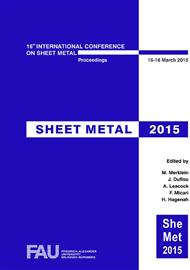p.213
p.221
p.227
p.235
p.243
p.251
p.259
p.267
p.275
Improvement of the Ductility of Press-Hardened Plane Sheets through a Modified Heat Treatment
Abstract:
Tailored press-hardening processes are used to reduce both production costs and component weight. The aim of these development methods is to generate regions zones in the component with both high and low tensile strengths. The B-pillar, for instance, needs high tensile strength in the region of the roof frame to prevent deformation. However, the connection to the body should have lower tensile strength to absorb the energy of a crash.Regarding the production process for tailored welded blanks, the tailored press-hardening processes for monolithic sheets need no joining operation. As an addition to recent publications, this paper presents a modified tailored press-hardening process, with a modified time-temperature process. Starting from the required tailored material properties of the part, with a sheet thickness of 1.5 mm, research has been done on the process window and process design.This contribution concentrates on modifications to the time-temperature profile. After heating the hot-dip galvanized, heat-treatable 22MnB5 steel above its austenitic temperature, the aim is to adjust the material’s mechanical properties within the cooling process.Based on the continuous TTT diagram, the cooling rate has an impact on the material’s mechanical material properties. Different proportions of constituents such as Bainite, Ferrite or Perlite are created by varying the cooling rate. Furthermore, during an intermediate stage in the cooling-down period, the holding temperature has an even stronger effect on the material’s microstructural composition and the corresponding mechanical properties. The rate of the transformation process changes, depending on the intermediate temperature. The third parameter investigated is the holding time at this intermediate temperature. As the holding time is increased a transformation, progressing from austenite to other constituents, can be observed.The results of this parametric study could be transferred to a prototype environment.
Info:
Periodical:
Pages:
243-248
Citation:
Online since:
March 2015
Authors:
Keywords:
Price:
Сopyright:
© 2015 Trans Tech Publications Ltd. All Rights Reserved
Share:
Citation:


